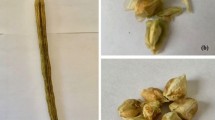Abstract
Moringa oleifera (MO) is a multipurpose, medium- or small-sized tree, from regions of north-west India and indigenous to many parts of Asia, Africa, and South America. Its pods have been employed as an inexpensive and effective sorbent for the removal of organics, and coagulant for water treatment. It is a non-toxic natural organic polymer. The main objective of this work was to use the MO seeds as a natural adsorbent for the treatment of dairy industry wastewater (DIW). The effects of agitation time, pH, MO biomass dose, and DIW concentration were evaluated. Removal efficiencies of up to 98%, for both color and turbidity, were reached using 0.2 g MO and 0.2 L of 1.0 g/L sorbate solution (DIW). The obtained results showed that MO seed keeps its adsorption power under a pH range between 5 and 8. The adsorption data was fitted to Langmuir isotherm. There was a significant uptake capacity of MO biomass, qmax, which suggested a good affinity between DIW components and sorbent. We conclude that the MO biomass has the potential to be used in the dairy industry wastewater treatment in an efficient way and with low cost.







Similar content being viewed by others
References
Akhtar, M., Moosa Hasany, S., Bhanger, M. I., & Iqbal, S. (2007a). Sorption potential of Moringa oleifera pods for the removal of organic pollutants from aqueous solutions. Journal of Hazardous Materials, 141(3), 546–556. doi:10.1016/j.jhazmat.2006.07.016.
Akhtar, M., Hasany, S. M., Bhanger, M. I., & Iqbal, S. (2007b). Low cost sorbents for the removal of methyl parathion pesticide from aqueous solutions. Chemosphere, 66, 1829–1838. doi:10.1016/j.chemosphere.2006.09.006.
Akhtar, M., Iqbal, S., Bhanger, M. I., Zia-Ul-Haq, M., & Moazzam, M. (2009). Sorption of organophosphorous pesticides onto chickpea husk from aqueous solutions. Colloids and Surfaces B: Biointerfaces, 69, 63–70.
Alila, S., & Boufi, S. (2009). Removal of organic pollutants from water by modified cellulose fibres. Industrial Crops and Products, 30(July 2009), 93–104.
APHA—American Public Health Association. (1995). Standard Methods for the Examination for Water and Wastewater, 19th ed., Washington, D.C.
Bhatia, S., Othman, Z., & Ahmad, A. L. (2007). Pretreatment of palm oil mill effluent (POME) using Moringa oleifera seeds as natural coagulant. Journal of Hazardous Materials, 145(1–2), 120–126. doi:10.1016/j.jhazmat.2006.11.003.
Bhatti, H. N., Mumtaz, B., Hanif, M. A., & Nadeem, R. (2007). Removal of Zn (II) ions from aqueous solution using Moringa oleifera Lam. (horseradish tree) biomass. Process Biochemistry, 42, 547–553. doi:0.1016/j.procbio.2006.10.009.
Bhuptawat, H., Folkard, G. K., & Chaudhari, S. (2007). Innovative physico-chemical treatment of wastewater incorporating Moringa oleifera seed coagulant. Journal of Hazardous Materials, 142(1-2), 477–482. doi:10.1016/j.jhazmat.2006.08.044.
Freundlich, H. (1926). Colloid and capillary chemistry (pp. 397–414). London: Methuen.
Gassenschmidt, U., Jany, K. D., Tauscher, B., & Niebergall, H. (1995). Isolation and characterization of a flocculating protein from Moringa oleifera Lam. Biochimica et Biophysica Acta (BBA)—General Subjects, 1243, 477–481. doi:10.1016/0304-4165(94)00176-X.
Gavala, H. N., Kopsinis, H., Skiadas, I. V., Stamatelatou, K., & Lyberatos, G. (1999). Treatment of dairy wastewater using an upflow anaerobic sludge blanket reactor. Journal of Agricultural Engineering Research, 73(1), 59–63.
Ghebremichael, K. A., Gunaratna, K. R., Henriksson, H., Brumer, H., & Dalhammar, G. (2005). A simple purification and activity assay of the coagulant protein from Moringa oleifera seed. Water Research, 39, 2338–2344. doi:10.1016/j.watres.2005.04.012.
Katayon, S., Noor, M. J. M. M., Asma, M., Ghani, L. A. A., Thamer, A. M., Azni, I., et al. (2006). Effects of storage conditions of Moringa oleifera seeds on its performance in coagulation. Bioresource Technology, 97(13), 1455–1460. doi:10.1016/j.biortech.2005.07.031.
Kumari, P., Sharma, P., Srivastava, S., & Srivastava, M. M. (2006). Biosorption studies on shelled Moringa oleifera Lamarck seed powder: removal and recovery of arsenic from aqueous system. International Journal of Mineral Processing, 78, 131–139. doi:10.1016/j.minpro.2005.10.001.
Langmuir, I. (1918). The adsorption of gases on plane surface of glass, mica and platinum. Journal of the Chemical Society, 40, 1361–1403. doi:10.1021/ja02242a004.
Ndabigengesere, A., & Narasiah, K. S. (1998). Quality of water treated by coagulation using Moringa oleifera seeds. Water Research, 32, 781–791. doi:10.1016/S0043-1354(97)00295-9.
Ndabigengesere, A., Subba Narasiah, K., & Talbot, B. G. (1995). Active agents and mechanism of coagulation of turbid waters using Moringa oleifera. Water Research, 29(2), 703–710. doi:10.1016/0043-1354(94)00161-Y.
Okuda, T., Baes, A. U., Nishijima, W., & Okada, M. (1999). Improvement of extraction method of coagulation active components from Moringa oleifera seed. Water Research, 33(15), 3373–3378. doi:10.1016/S0043-1354(99)00046-9.
Okuda, T., Baes, A. U., Nishijima, W., & Okada, M. (2001). Coagulation mechanism of salt solution-extracted active component in Moringa oleifera seeds. Water Research, 35(3), 830–834. doi:10.1016/S0043-1354(00)00296-7.
Parab, H., Joshi, S., Shenoy, N., Lali, A., Sarma, U. S., & Sudersanan, M. (2006). Determination of kinetic and equilibrium parameters of the batch adsorption of Co(II), Cr(III) and Ni(II) onto coir pith. Process Biochemistry, 41, 609–615. doi:10.1016/j.procbio.2005.08.006.
Sciban, M., Klasnja, M., & Skrbic, B. (2006). Modified softwood sawdust as adsorbent of heavy metal ions from water. Journal of Hazardous Materials, B136, 266–271. doi:10.1016/j.jhazmat.2005.12.009.
Sharma, P., Kumari, P., Srivastava, M. M., & Srivastava, S. (2006). Removal of cadmium from aqueous system by shelled Moringa oleifera Lam. seed powder. Bioresource Technology, 97(2), 299–305. doi:10.1016/j.biortech.2005.02.034.
Acknowledgement
The authors would like to thank the Brazilian research funding National Council for Scientific and Technological Development (CNPq).
Author information
Authors and Affiliations
Corresponding author
Rights and permissions
About this article
Cite this article
Vieira, A.M.S., Vieira, M.F., Silva, G.F. et al. Use of Moringa oleifera Seed as a Natural Adsorbent for Wastewater Treatment. Water Air Soil Pollut 206, 273–281 (2010). https://doi.org/10.1007/s11270-009-0104-y
Received:
Accepted:
Published:
Issue Date:
DOI: https://doi.org/10.1007/s11270-009-0104-y




